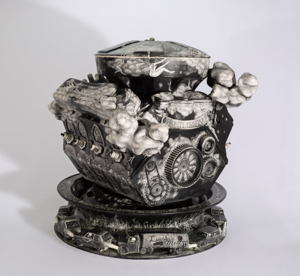Artistic Inspirations
David Regan
David Regan
American, born 1964
V8 Universe, 2003
Porcelain
19 1/2 x 22 x 17 1/4 inches (49.5 x 56 x 44 cm)
Memorial Art Gallery of the University of Rochester; Maurice R. and Maxine B. Forman Fund
Photography, David O. Brown
Image credit: David Regan (10 images)
One of Dante’s significant contributions to Western literature—the idea that Hell could have a definable structure—drove ceramic artist David Regan to ask the question: “how might an auto mechanic envision Hell?” The resulting work is a whimsical but profound vision suggesting how a mechanically-inclined mind might organize the afterlife. Regan’s idea is actually not that far-fetched with respect to Dante, who also envisioned Hell in terms of real architectures reinterpreted through the medieval scholastic tradition which places all human beings in an ordered and hierarchical universe.
Regan’s piece takes the form of an eight-cylinder or V8 engine. Its pedestal, a tireless wheel rim representing the circular boundary of Hell, features a procession of cars and trucks driven by the dead, all snarled in an endless, circular traffic jam. The engine block itself, with its architectural symmetry reminiscent of a gothic cathedral complete with a gear reminiscent of a stained-glass rose window, is Purgatory, its iconography fueled by Regan’s childhood as a choirboy in the Russian Orthodox Church. The monks—in frieze-like procession along its side–carry exhaust pipes, transmissions, and wrenches in lieu of liturgical items. Atop the engine, the round air filter housing serves as Heaven, teeming with frolicking nude female angels—a stereotypical working man’s vision of Paradise.
In its form and detailed decoration, V8 Universe also brings to mind the heavy silver reliquaries typical of the Russian Orthodox tradition. Regan achieves the incredible intricacy of the drawing using the sgraffito technique—coating the white porcelain form in a layer of black slip, he then selectively scratches it away with small gouges, chisels, and needles before adding a final clear glaze and firing. The result is a complex work whose familiar form and irreverent tone draw in the viewer, creating a space for discussion of weightier topics.
